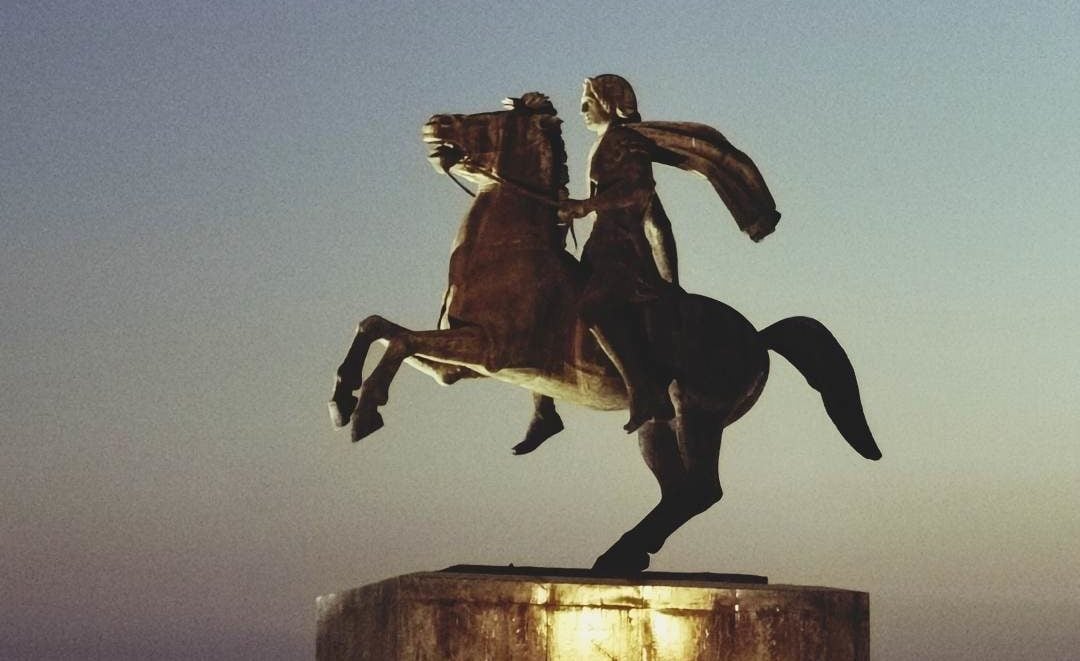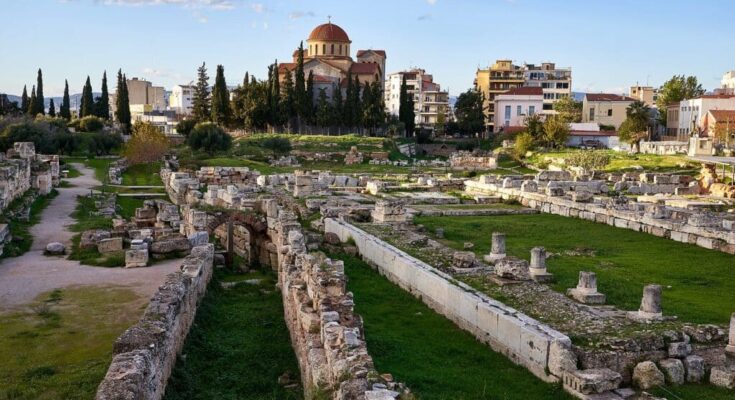
In the archaeological site of Kerameikos in Athens, Greece, there is an ancient tomb of an Indian Buddhist monk named Zarmanochegas.
Kerameikos is the most important cemetery of Ancient Athens which came into existence in the 12th Century B.C. It derives its name from the very old community of the city quarter Kerameis who had settled on the banks of the river Eridanos. When the Eridanos River flowed through here, it produced an orange-red clay ideal for pottery (Keramos in Greek).
The community of pottery artisans was named Kerameikos and their style of elaborately painted earthenware was called Kerameikos (Greek for ceramic). Mythology credits Keramos (Ceramus) for lending his name. He was the lord of the Keramaikos pottery district and the mortal son of Dionysus, the god of wine who went on a campaign to India.
The 11-acre archaeological site is filled with tombstones and statues of astonishing design and quality. One of these tombs is that of an Indian Buddhist monk. On his tomb was placed this inscription: “Here lies Zarmanochegas, of Barygaza, who according to the ancestral custom of the Indians gave himself immortality.”
Tamil or Punjabi Mission?
Scholars have been debating whether the mission Zarmanochegas was a part of to the court of Romans via Athens, was sent by a Tamil King or a Punjabi King of India.
Pakistani journalist Majid Sheikh mentions in his article in Dawn newspaper “in my student days while hitch-hiking through Europe, I stumbled across a mysterious tomb of Porus’ (King of Punjab area now divided between India and Pakistan) ambassador…”History tells us that ‘Zarmanochegas’ was a Rajput Khokhar from Lahore and reached Athens along with his 85 slaves. He was honored with a tomb in Athens.

As per R. N. Dandekar in his research paper SOME ASPECTS OF THE INDO-MEDITERRANEAN CONTACTS published by Bhandarkar Oriental Research Institute, a Pandya embassy, under the leadership of Zarmanochegas (Sramanacarya), had left Bhrukaccha (Barygaza) in 25 B. C. and waited upon Augustus at Sumos in 21 B. C. with presents for the Emperor which are said to have consisted, among other things, of a gigantic python, huge tortoises, and an armless boy who could shoot arrows with his feet.
Pandyas were a Tamil dynasty of Dravidian origin, hence, if what Dandekar mentions is right, then Zarmanochegas was part of a Tamil mission to Roman court via Athens.
Indian Buddhist Monk Zarmanochegas Self-Immolated in Athens
As per Kim Han-Sang HK Research Professor at Hankuk University of Foreign Studies, South Korea, self-immolation refers to ascetic Buddhist practices that include the voluntary termination of one’s life or the offering of parts of one’s body usually by setting oneself ablaze. In both the Northern (Mahayana) and Southern (Theravada) Buddhist traditions, self-immolation has been considered a heroic bodhisattva act to end one’s life with a spiritual motivation and strong sense of determination.

Zarmanochegas was not the first Indian monk to self immolate himself in front of ancient Greeks; long before him, Alexander the Great’s friend Kalanos or Swami Kalyan also did it.
When the Macedonian army reached North Western India, Alexander met gymnosophist Dandamis. Alexander wanted him to come with him back to Greece but he refused, but one of the Gymnosophistai there, a man named Kalanos (Indian Kalyana), followed the conqueror to the west, where he died. The story of the interview and the story of the death of Kalanos are described in several sources, such as the Anabasis by the Greek author Arrian of Nicomedia.

It was in Persia that Kalanos mounted the pyre and with due ceremony laid himself down. All the troops were watching. Alexander could not but feel that there was a sort of indelicacy in witnessing such a spectacle – the man, after all, had been his friend; everyone else, however, felt nothing but astonishment to see Kalanos give not the smallest sign of shrinking from the flames.

We read in Nearchus’s account of this incident that at the moment the fire was kindled there was, by Alexander’s orders, an impressive salute: the bugles sounded, the troops with one accord roared out their battle-cry, and the elephants joined in with their shrill war trumpetings.
Details of Mission of Zarmanochegas
As per Strabo, during the rule of Emperor Augustus, a Pandya embassy, under the leadership of Zarmanochegas (Sramanacarya), had left Bhrgukaccha in 25 B. C. and waited upon Augustus at Samos in 21 B. C. with presents for the Emperor, which are said to have consisted, among other things, of a gigantic python, huge tortoises, and an armless boy who could shoot arrows with his feet.
Indeed, at least nine embassies from India are known to have visited Roman emperors up to the times of Constantine. The purpose of these embassies must have been both diplomatic and commercial. Indian philosophy seems to have made a tremendous impression upon the thinkers of the Graeco-Roman world.
As per Roman History by Cassius Dio Book LIV “…the people of India, who had already made overtures, now made a treaty of friendship, sending among other gifts tigers, which were then for the first time seen by the Romans, as also, I think by the Greeks. They also gave him a boy who had no shoulders or arms, like our statues of Hermes and yet, defective as he was, he could use his feet for everything, as if they were hands: with them he would stretch a bow, shoot missiles, and put a trumpet to his lips.
How he did this I do not know; I merely state what is recorded. One of the Indians, Zarmarus, for some reason wished to die, — either because, being of the caste of sages, he was on this account moved by ambition, or, in accordance with the traditional custom of the Indians, because of old age, or because he wished to make a display for the benefit of Augustus and the Athenians (for Augustus had reached Athens);— he was therefore initiated into the mysteries of the two goddesses, which were held out of season on account, they say, of Augustus, who also was an initiate, and he then threw himself alive into the fire.”
The mission of Zarmanochegas was an attempt to create a stronger relationship between India and Rome, but his self-immolation in Athens astonished the Greeks, like that of Kalanos several years before him had astonished the Macedonian soldiers of Alexander the Great.



